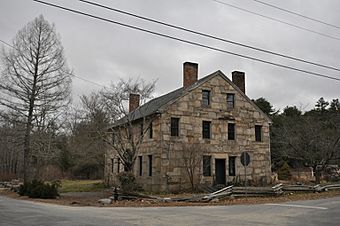Daniel's Village Archeological Site facts for kids
Quick facts for kids |
|
|
Daniel's Village Archeological Site
|
|

Stone house
|
|
| Location | Killingly, Connecticut |
|---|---|
| Built | 1760 |
| Architectural style | Georgian |
| NRHP reference No. | 78002861 |
| Added to NRHP | March 30, 1978 |
The Daniel's Village Archeological Site is a very old and important place in Killingly, Connecticut. It's located near where Putnam Road crosses the Five Mile River. This area was once home to one of the very first textile mills in Connecticut.
Sadly, the mills burned down in 1861 and were never rebuilt. This meant the village lost its main reason for existing. The site was recognized for its history and added to the National Register of Historic Places in 1978. In 2015, a history expert bought the entire site, putting the original land back together. Today, it is private property.
Contents
The Village's Past
Early Beginnings
People started living in this area in the early 1700s. It had an industrial history even back then. An old mill called Talbot's Mill, which ground grain, was already working here.
Growing into a Mill Town
In 1814, local landowners teamed up with investors from Rhode Island. They decided to build a cotton mill at the site. It was first known as Howe's Factory, named after its managers.
The Daniels family bought the factory in 1845. By this time, the village had grown quite a bit. It included a store, a blacksmith's shop, and at least nine homes for the workers. There were also three separate mill buildings.
The End of the Mills
The mill buildings caught fire in 1861 and were completely destroyed. They were never rebuilt after the fire. The Daniels family sold the property in 1888. By the early 1900s, what was left of the village had turned into ruins.
What You Can Still See
Even though the village is gone, some parts of it are still visible today.
Stone Structures
You can see an old stone dam from the early 1800s. There's also a stone house at the corner of Putnam and Stone Roads. This house was built after the 1814 purchase. It has a classic Georgian style with a pointed roof and five windows across the front.
Mill Foundations
You can also find parts of the mill's foundations. These include pieces of the channels that carried water away from both the old grain mill and the cotton mills. Near the stone house, you can see the remains of the foundations for some of the workers' homes.



